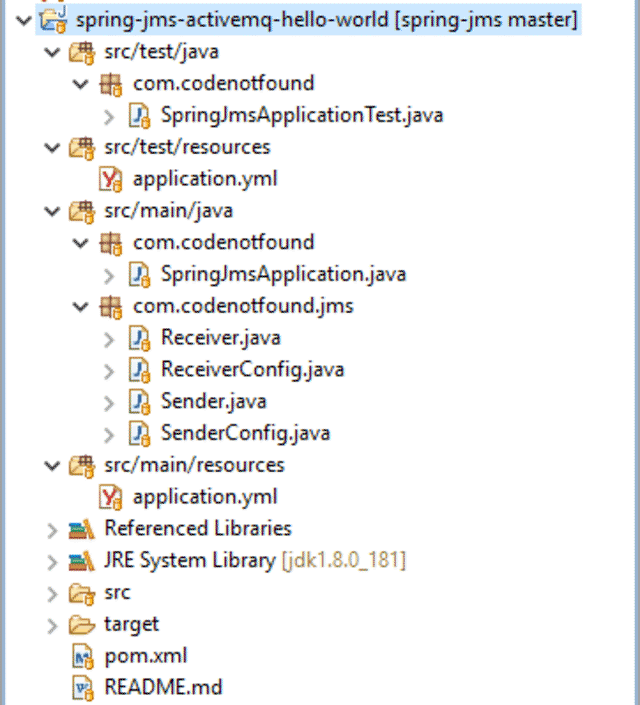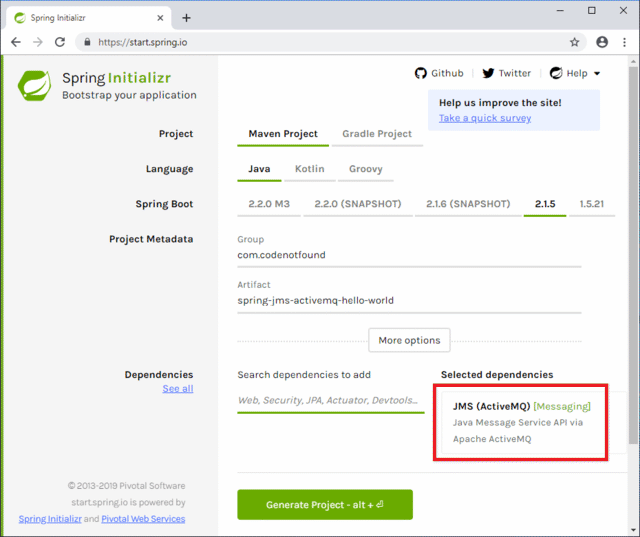Spring JMS ActiveMQ Example
Table of Contents
I’m going to show you EXACTLY how to create a Spring JMS Hello World example that uses Spring Boot, ActiveMQ, and Maven.
(Step-by-step)
So if you’re a Spring JMS beginner, you’ll love this guide.
Let’s get this show on the road!
What is Spring JMS? #
Spring provides a JMS integration framework that simplifies the use of the JMS API. Much like Spring’s integration does for the JDBC API.
The Spring Framework will take care of some low-level details when working with the JMS API.
In this tutorial, we will create a Hello World example in which we will send/receive a message to/from Apache ActiveMQ using Spring JMS, Spring Boot, and Maven.
General Project Overview #
We will use the following tools/frameworks:
- Spring JMS 5.1
- Spring Boot 2.1
- ActiveMQ 5.15
- Maven 3.6
Our project has the following directory structure:

Maven Setup #
We build and run our example using Maven. If not already the case, download and install Apache Maven.
Let’s use Spring Initializr to generate our Maven project. Make sure to select JMS (ActiveMQ) as a dependency.

Click Generate Project to generate and download the Spring Boot project template. At the root of the project, you’ll find a pom.xml file which is the XML representation of the Maven project.
To avoid having to manage the version compatibility of the different Spring dependencies, we will inherit the defaults from the spring-boot-starter-parent parent POM.
The generated project contains Spring Boot Starters that manage the different Spring dependencies.
You can find back the exact dependency versions in Appendix F of the reference documentation. For Spring Boot 2.1.5 the ActiveMQ dependency is version 5.15.9.
The spring-boot-starter-activemq dependency includes the needed dependencies for using Spring JMS in combination with ActiveMQ.
The spring-boot-starter-test includes the dependencies for testing Spring Boot applications with libraries that include JUnit, Hamcrest and Mockito.
In the plugins section, you’ll find the Spring Boot Maven Plugin. spring-boot-maven-plugin allows us to build a single, runnable “uber-jar”. This is a convenient way to execute and transport code.
Also, the plugin allows you to start the example via a Maven command.
<?xml version="1.0" encoding="UTF-8"?>
<project xmlns="http://maven.apache.org/POM/4.0.0"
xmlns:xsi="http://www.w3.org/2001/XMLSchema-instance"
xsi:schemaLocation="http://maven.apache.org/POM/4.0.0 http://maven.apache.org/xsd/maven-4.0.0.xsd">
<modelVersion>4.0.0</modelVersion>
<groupId>com.codenotfound</groupId>
<artifactId>spring-jms-activemq-hello-world</artifactId>
<version>0.0.1-SNAPSHOT</version>
<name>spring-jms-activemq-hello-world</name>
<description>Spring JMS ActiveMQ Example</description>
<url>https://codenotfound.com/spring-jms-activemq-example.html</url>
<parent>
<groupId>org.springframework.boot</groupId>
<artifactId>spring-boot-starter-parent</artifactId>
<version>2.1.5.RELEASE</version>
<relativePath /><!-- lookup parent from repository -->
</parent>
<properties>
<java.version>11</java.version>
</properties>
<dependencies>
<dependency>
<groupId>org.springframework.boot</groupId>
<artifactId>spring-boot-starter-activemq</artifactId>
</dependency>
<dependency>
<groupId>org.springframework.boot</groupId>
<artifactId>spring-boot-starter-test</artifactId>
<scope>test</scope>
</dependency>
</dependencies>
<build>
<plugins>
<plugin>
<groupId>org.springframework.boot</groupId>
<artifactId>spring-boot-maven-plugin</artifactId>
</plugin>
</plugins>
</build>
</project>
Spring Boot Setup #
Spring Boot is used in order to make a Spring JMS example application that you can “just run”.
We start by creating a SpringJmsApplication which contains the main() method that uses Spring Boot’s SpringApplication.run() method to launch the application.
The
@SpringBootApplicationannotation is a convenience annotation that adds:@Configuration,@EnableAutoConfigurationand@ComponentScan.
For more information on Spring Boot check out the Spring Boot getting started guide.
package com.codenotfound;
import org.springframework.boot.SpringApplication;
import org.springframework.boot.autoconfigure.SpringBootApplication;
@SpringBootApplication
public class SpringJmsApplication {
public static void main(String[] args) {
SpringApplication.run(SpringJmsApplication.class, args);
}
}
The below sections will detail how to create a sender and receiver together with their respective configurations.
It is also possible to have Spring Boot autoconfigure Spring JMS using default values so that actual code that needs to be written is reduced to a bare minimum.
Create a Spring JMS Message Producer #
For sending messages we will be using the JmsTemplate which requires a reference to a ConnectionFactory. The template provides convenience methods which handle the creation and release of resources when sending or synchronously receiving messages.
In the below Sender class, the JmsTemplate is auto-wired as the actual creation of the Bean will be done in a separate SenderConfig class.
In this tutorial we will use the convertAndSend() method which sends the given object to the helloworld.q destination, converting the object to a JMS message.
The type of JMS message depends on the type of the object being passed. In the case of a String, a JMS TextMessage will be created.
For more detailed information on how to send JMS messages, check the Spring JmsTemplate Example.
package com.codenotfound.jms;
import org.slf4j.Logger;
import org.slf4j.LoggerFactory;
import org.springframework.beans.factory.annotation.Autowired;
import org.springframework.jms.core.JmsTemplate;
public class Sender {
private static final Logger LOGGER =
LoggerFactory.getLogger(Sender.class);
@Autowired
private JmsTemplate jmsTemplate;
public void send(String message) {
LOGGER.info("sending message='{}'", message);
jmsTemplate.convertAndSend("helloworld.q", message);
}
}
The creation of the JmsTemplate and Sender is handled in the SenderConfig class. This class is annotated with @Configuration which indicates that the class can be used by the Spring IoC container as a source of bean definitions.
In order to be able to use the Spring JMS template, we need to provide a reference to a ConnectionFactory which is used to create connections with the JMS provider. In addition, it encapsulates various configuration parameters, many of which are vendor specific.
In the case of ActiveMQ, we use the ActiveMQConnectionFactory.
On the ActiveMQConnectionFactory we set the broker URL which is fetched from the application.yml properties file using the @Value annotation.
activemq:
broker-url: tcp://localhost:61616
The JmsTemplate was originally designed to be used in combination with a J2EE container where the container would provide the necessary pooling of the JMS resources.
As we are running this example on Spring Boot, we will wrap ActiveMQConnectionFactory using Spring’s CachingConnectionFactory in order to still have the benefit of caching of sessions, connections, and producers as well as automatic connection recovery.
package com.codenotfound.jms;
import org.apache.activemq.ActiveMQConnectionFactory;
import org.springframework.beans.factory.annotation.Value;
import org.springframework.context.annotation.Bean;
import org.springframework.context.annotation.Configuration;
import org.springframework.jms.connection.CachingConnectionFactory;
import org.springframework.jms.core.JmsTemplate;
@Configuration
public class SenderConfig {
@Value("${activemq.broker-url}")
private String brokerUrl;
@Bean
public ActiveMQConnectionFactory senderActiveMQConnectionFactory() {
ActiveMQConnectionFactory activeMQConnectionFactory =
new ActiveMQConnectionFactory();
activeMQConnectionFactory.setBrokerURL(brokerUrl);
return activeMQConnectionFactory;
}
@Bean
public CachingConnectionFactory cachingConnectionFactory() {
return new CachingConnectionFactory(
senderActiveMQConnectionFactory());
}
@Bean
public JmsTemplate jmsTemplate() {
return new JmsTemplate(cachingConnectionFactory());
}
@Bean
public Sender sender() {
return new Sender();
}
}
Create a Spring JMS Message Consumer #
Like with any messaging-based application, you need to create a receiver that will handle the messages that have been sent. The below Receiver is nothing more than a simple POJO that defines a method for receiving messages. In this guide we named the method receive(), but you can name it anything you like.
The @JmsListener annotation creates a message listener container behind the scenes for each annotated method, using a JmsListenerContainerFactory. By default, a bean with name jmsListenerContainerFactory is expected that we will set up in the next section.
Using the destination element, we specify the destination for this listener. In the below example we set the destination to helloworld.q.
For testing convenience, we added a
CountDownLatch. This allows the POJO to signal that a message is received. This is something you are not likely to implement in a production application.
package com.codenotfound.jms;
import java.util.concurrent.CountDownLatch;
import org.slf4j.Logger;
import org.slf4j.LoggerFactory;
import org.springframework.jms.annotation.JmsListener;
public class Receiver {
private static final Logger LOGGER =
LoggerFactory.getLogger(Receiver.class);
private CountDownLatch latch = new CountDownLatch(1);
public CountDownLatch getLatch() {
return latch;
}
@JmsListener(destination = "helloworld.q")
public void receive(String message) {
LOGGER.info("received message='{}'", message);
latch.countDown();
}
}
The creation and configuration of the different Spring Beans needed for the Receiver POJO are grouped in the ReceiverConfig class.
Note that we need to add the
@EnableJmsannotation to enable support for the@JmsListenerannotation that was used on theReceiver.
The jmsListenerContainerFactory() is expected by the @JmsListener annotation from the Receiver.
Contrary to the JmsTemplate ideally don’t use Spring’s CachingConnectionFactory with a message listener container at all. Reason for this is that it is generally preferable to let the listener container itself handle appropriate caching within its lifecycle.
As we are connecting to ActiveMQ, an ActiveMQConnectionFactory is created and passed in the constructor of the DefaultJmsListenerContainerFactory.
More details on how to receive JMS messages can be found in the Spring JMS Listener Example.
package com.codenotfound.jms;
import org.apache.activemq.ActiveMQConnectionFactory;
import org.springframework.beans.factory.annotation.Value;
import org.springframework.context.annotation.Bean;
import org.springframework.context.annotation.Configuration;
import org.springframework.jms.annotation.EnableJms;
import org.springframework.jms.config.DefaultJmsListenerContainerFactory;
@Configuration
@EnableJms
public class ReceiverConfig {
@Value("${activemq.broker-url}")
private String brokerUrl;
@Bean
public ActiveMQConnectionFactory receiverActiveMQConnectionFactory() {
ActiveMQConnectionFactory activeMQConnectionFactory =
new ActiveMQConnectionFactory();
activeMQConnectionFactory.setBrokerURL(brokerUrl);
return activeMQConnectionFactory;
}
@Bean
public DefaultJmsListenerContainerFactory jmsListenerContainerFactory() {
DefaultJmsListenerContainerFactory factory =
new DefaultJmsListenerContainerFactory();
factory
.setConnectionFactory(receiverActiveMQConnectionFactory());
return factory;
}
@Bean
public Receiver receiver() {
return new Receiver();
}
}
Testing the Spring JMS Example #
Spring Boot will automatically start an embedded broker if the following conditions are met:
- ActiveMQ is on the classpath
- No broker URL is specified through
spring.activemq.broker-url
Let’s use the embedded broker for testing. We add a dedicated application.yml properties file under src/test/resources. Inside we specify the VM URI as broker connection URL.
activemq:
broker-url: vm://embedded-broker?broker.persistent=false
Next, we create a basic SpringJmsApplicationTest class to verify that we are able to send and receive a message to and from ActiveMQ.
It contains a testReceive() unit test case that uses the Sender to send a message to the helloworld.q queue on the ActiveMQ message broker. We then use the CountDownLatch from the Receiver to verify that a message was received.
package com.codenotfound;
import static org.assertj.core.api.Assertions.assertThat;
import java.util.concurrent.TimeUnit;
import org.junit.Test;
import org.junit.runner.RunWith;
import org.springframework.beans.factory.annotation.Autowired;
import org.springframework.boot.test.context.SpringBootTest;
import org.springframework.test.context.junit4.SpringRunner;
import com.codenotfound.jms.Receiver;
import com.codenotfound.jms.Sender;
@RunWith(SpringRunner.class)
@SpringBootTest
public class SpringJmsApplicationTest {
@Autowired
private Sender sender;
@Autowired
private Receiver receiver;
@Test
public void testReceive() throws Exception {
sender.send("Hello Spring JMS ActiveMQ!");
receiver.getLatch().await(10000, TimeUnit.MILLISECONDS);
assertThat(receiver.getLatch().getCount()).isEqualTo(0);
}
}
In order to execute the above test, open a command prompt in the project root directory and run following Maven command:
mvn test
Maven will download the dependencies, compile the code and run the unit test case. The result should be a successful build as shown below:
. ____ _ __ _ _
/\\ / ___'_ __ _ _(_)_ __ __ _ \ \ \ \
( ( )\___ | '_ | '_| | '_ \/ _` | \ \ \ \
\\/ ___)| |_)| | | | | || (_| | ) ) ) )
' |____| .__|_| |_|_| |_\__, | / / / /
=========|_|==============|___/=/_/_/_/
:: Spring Boot :: (v2.1.5.RELEASE)
2019-05-30 08:39:06.606 INFO 13060 --- [ main] c.codenotfound.SpringJmsApplicationTest : Starting SpringJmsApplicationTest on DESKTOP-2RB3C1U with PID 13060 (started by Codenotfound in C:\Users\Codenotfound\repos\spring-jms\spring-jms-activemq-hello-world)
2019-05-30 08:39:06.608 INFO 13060 --- [ main] c.codenotfound.SpringJmsApplicationTest : No active profile set, falling back to default profiles: default
2019-05-30 08:39:08.007 INFO 13060 --- [ main] o.apache.activemq.broker.BrokerService : Using Persistence Adapter: MemoryPersistenceAdapter
2019-05-30 08:39:08.082 INFO 13060 --- [ JMX connector] o.a.a.broker.jmx.ManagementContext : JMX consoles can connect to service:jmx:rmi:///jndi/rmi://localhost:1099/jmxrmi
2019-05-30 08:39:08.154 INFO 13060 --- [ main] o.apache.activemq.broker.BrokerService : Apache ActiveMQ 5.15.9 (embedded-broker, ID:DESKTOP-2RB3C1U-56942-1559198348025-0:1) is starting
2019-05-30 08:39:08.160 INFO 13060 --- [ main] o.apache.activemq.broker.BrokerService : Apache ActiveMQ 5.15.9 (embedded-broker, ID:DESKTOP-2RB3C1U-56942-1559198348025-0:1) started
2019-05-30 08:39:08.161 INFO 13060 --- [ main] o.apache.activemq.broker.BrokerService : For help or more information please see: http://activemq.apache.org
2019-05-30 08:39:08.191 INFO 13060 --- [ main] o.a.activemq.broker.TransportConnector : Connector vm://embedded-broker started
2019-05-30 08:39:08.234 INFO 13060 --- [ main] c.codenotfound.SpringJmsApplicationTest : Started SpringJmsApplicationTest in 1.994 seconds (JVM running for 3.161)
2019-05-30 08:39:08.591 INFO 13060 --- [ main] com.codenotfound.jms.Sender : sending message='Hello Spring JMS ActiveMQ!'
2019-05-30 08:39:08.624 INFO 13060 --- [enerContainer-1] com.codenotfound.jms.Receiver : received message='Hello Spring JMS ActiveMQ!'
[INFO] Tests run: 1, Failures: 0, Errors: 0, Skipped: 0, Time elapsed: 3.048 s - in com.codenotfound.SpringJmsApplicationTest
2019-05-30 08:39:08.709 INFO 13060 --- [MQ ShutdownHook] o.apache.activemq.broker.BrokerService : Apache ActiveMQ 5.15.9 (embedded-broker, ID:DESKTOP-2RB3C1U-56942-1559198348025-0:1) is shutting down
2019-05-30 08:39:08.721 INFO 13060 --- [MQ ShutdownHook] o.a.activemq.broker.TransportConnector : Connector vm://embedded-broker stopped
2019-05-30 08:39:08.731 INFO 13060 --- [MQ ShutdownHook] o.apache.activemq.broker.BrokerService : Apache ActiveMQ 5.15.9 (embedded-broker, ID:DESKTOP-2RB3C1U-56942-1559198348025-0:1) uptime 0.965 seconds
2019-05-30 08:39:08.731 INFO 13060 --- [MQ ShutdownHook] o.apache.activemq.broker.BrokerService : Apache ActiveMQ 5.15.9 (embedded-broker, ID:DESKTOP-2RB3C1U-56942-1559198348025-0:1) is shutdown
[INFO]
[INFO] Results:
[INFO]
[INFO] Tests run: 1, Failures: 0, Errors: 0, Skipped: 0
[INFO]
[INFO] ------------------------------------------------------------------------
[INFO] BUILD SUCCESS
[INFO] ------------------------------------------------------------------------
[INFO] Total time: 13.707 s
[INFO] Finished at: 2019-05-30T08:39:09+02:00
[INFO] ------------------------------------------------------------------------
Above test case can also be executed after you install Apache ActiveMQ on your local system.
Simply change the activemq:broker-url property to point to tcp://localhost:61616 in case the broker is running on the default URL.
This concludes our example in which we used Spring JMS and Spring Boot in order to connect to ActiveMQ.
If you found this sample useful or have a question you would like to ask.
Leave a comment below!